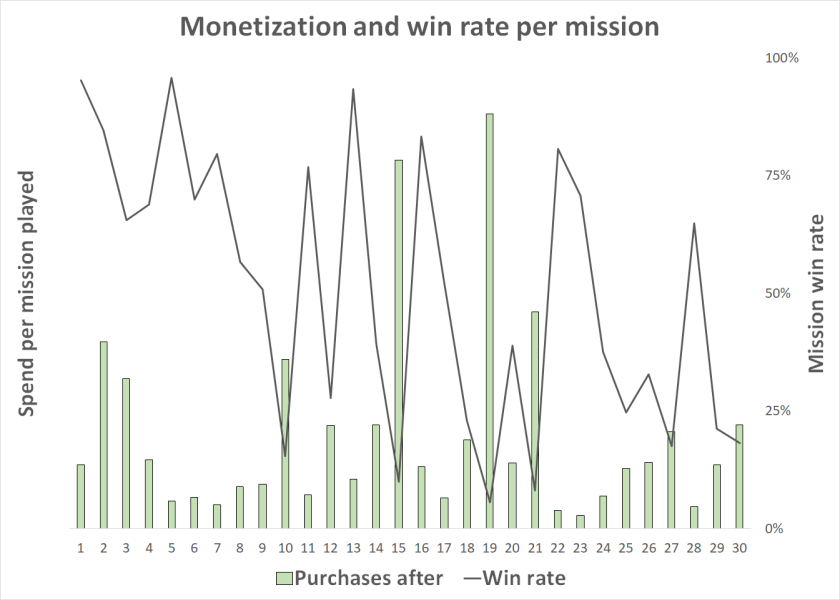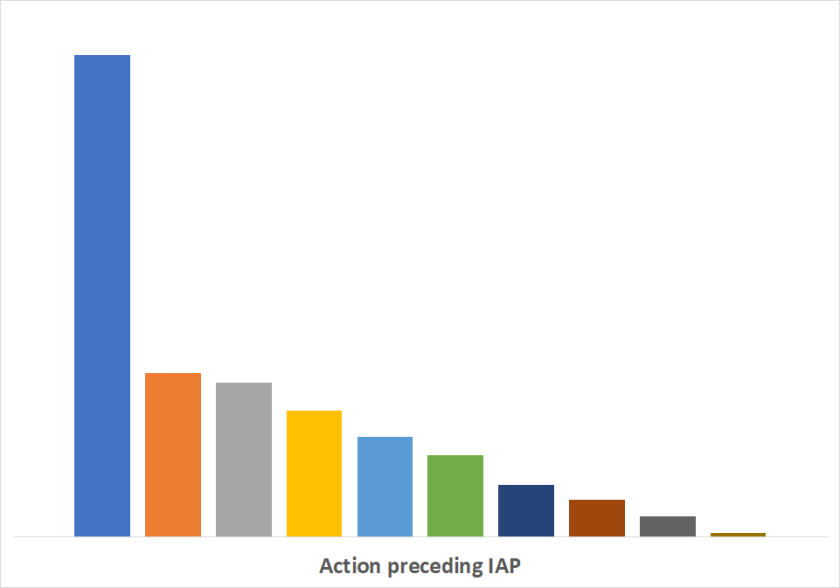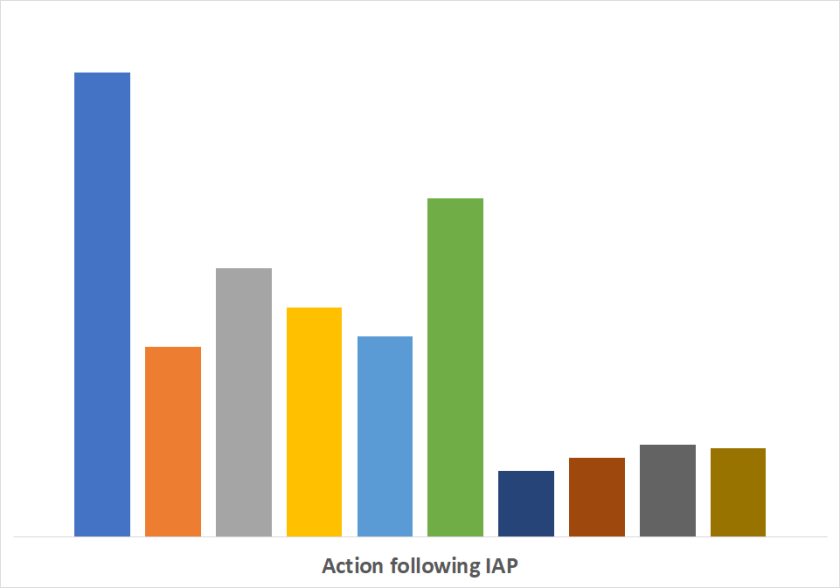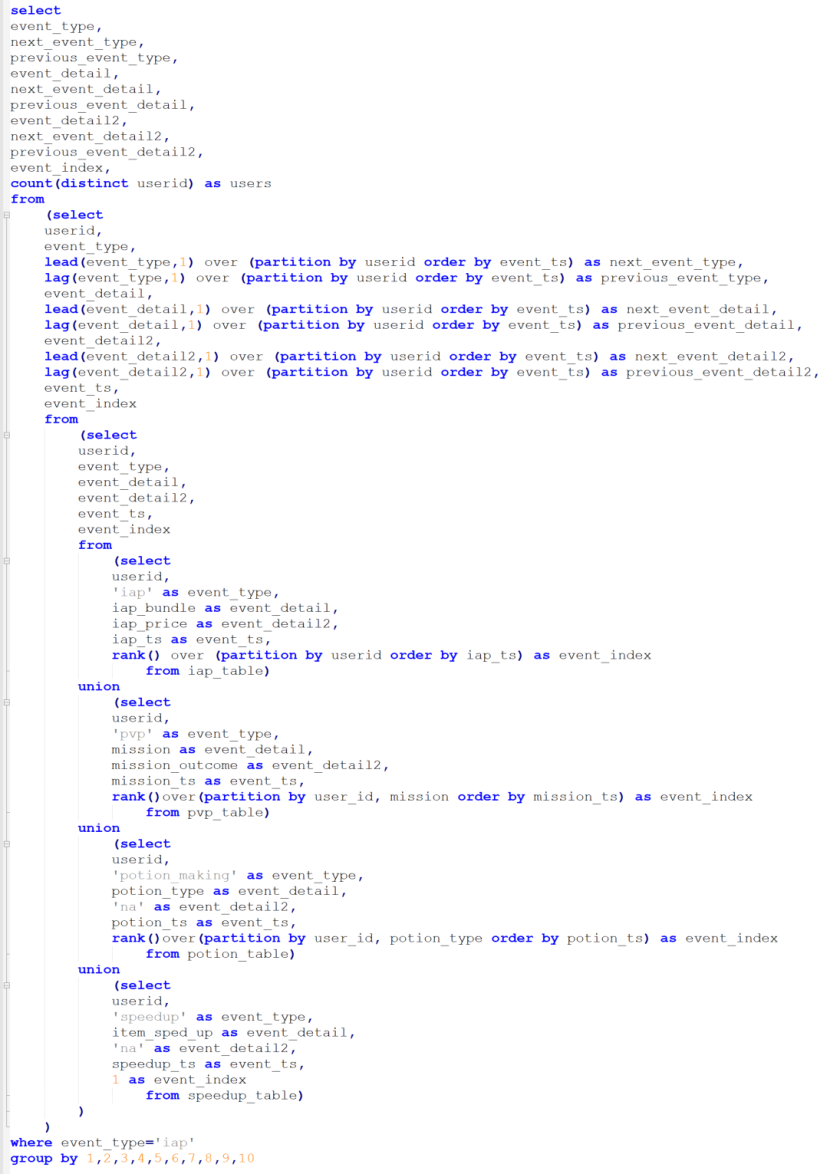In a previous post I discussed ways to identify what in-game purchases are driving IAPs. This is great to see what is motivating your users and driving them to spend: the assumption being that the first item purchased after an IAP was the reason to do the IAP in the first place. The more insights you get into what your customers find desirable, the more you can leverage that to optimize content, placement or pricing. And of course, you can leverage that to segment your players and provide them with better targeted offers.
There is another way to look at the flow that surrounds user purchase. In this case, you don’t focus on what in-game items players are purchasing following their IAP. Rather, you focus on the gameplay context, on the missions, game modes and in-game actions the customers are doing. In other words, looking at what players did immediately before and immediately after an IAP.
1) Before and after spending
Letting nature take over is all about identifying the situations the most conducive to spending, and trying to reproduce them as much as possible in your game. Most of the time, the same situations will produce the same outcomes. So, identifying which situations are the most associated to spending (and making them occur more often) will best help monetize your game.
When your game features a linear progression and there is a clear win condition, there is one thing you need to look at first: what are the missions that precede spending? Looking at things this way – especially if you map the purchases with the win rate of the mission, you can clearly identify the missions that are the most conducive to monetizing your users (keep in mind you want to look at relative monetization – as a percent of players actually playing the mission). Sometimes – especially for redepositing users – monetization reflects mission difficulty. The harder missions monetize the most. But there are other factors at play. In the example below mission 2 monetizes as much as mission 10 – but both have very different win rates.

But simply looking at spending from the perspective of mission progression and the mission that precedes spending is not enough. Another thing is what action/set of actions precede and follow spending. That’s crucial for 2 reasons.
First, even games with linear progression feature optional game modes or secondary loops that can directly drive spending. Most games feature much more than win/lose missions. If you only look at linear progression, you might be missing out on key monetization drivers. For example, multiple RPG games feature some kind of crafting or building mechanic. The wait times or required ingredients can be strong drivers to spend – even though they are not missions. When you only look at previous missions you are effectively blind to other dimensions of the game. Second, some games don’t even feature a strong or clear mission format with win conditions. Take for example City Builders, Simulators, Narrative games, 4x, Decoration games, etc.
The other important thing here is that you want to look at what happens both before and after an IAP. There is a very instrumental and functionalist assumption concerning monetization in free-to-play games. Basically, the idea is that a player will mainly spend to overcome difficulties and challenges s/he encountered. When you look at spending relative to difficulty, you are only looking backwards.
Monetizing to overcome friction is an aspect of free-to-play monetization. But not the only one (and I’d even argue not the main one). If you only look backwards, then you are excluding the possibility that monetization is aspirational. In other words, you need to approach monetization in a forward looking way. In some cases, players are not spending because of a blocker or frictions they encountered in the past. They are simply spending because something that lies ahead is inspirational and appealing.
When I got the offer for the legendary sword, I did not need it to move forward (I hadn’t come across any challenging mission yet) – but it looked really cool and I wanted it.
In the above example, what would be driving spending is not the last mission played – it’s rather the mission the user wants to play. It’s looking forward, anticipation and what’s aspirational (the player has no actual experience of the Smuggler’s Run missions until s/he plays them)
By looking at the main actions before and after spending, you can get some insights into what purchases are reactive, and what purchases are more aspirational: you can assess to what extent spending in your game is “forward looking” or “backwards looking”. By that I mean, are players mostly spending to overcome a difficulty they just encountered, or are players converting in anticipation of something ahead of them.
What you want to do when you will look at actions before and after spending is identify all relevant actions in the game that could drive user spending. This needs to be a judgment call on your part that requires an inside understanding on the game – as well as a capacity to empathize with the players and imagine the user stories where one game feature drives spending. Thinking about things this way requires thinking in terms of user flow, of what would be relevant before or after.


The first thing you need to do when you are looking at different categories is get a sense of what the main actions in your game are. If 90% of the actions in your game are action 1 (the blue bar), then having only 40% of purchases preceded of followed by that action is very telling – in this case that it’s not as strong a factor as other actions. If for example you see that there is a common action before spending – and no clear action after spending stands out – then that can be a good indication the action before spending is key. In the example above, you can see that action 3 (the grey bar) and action 6 (the green bar) are overrepresented in actions following purchases. This can be a good starting point to see how aspirational those features or in-game actions are.
You can find at the end of this post a sample query to gather that data for your game
2) Before and after conversion
The spending behavior for conversions is not always the same as the spending behavior for redeposits. To a certain extent, conversions are very scripted. Often conversions happen when players are presented with key offers placed strategically early in the player funnel. That’s why looking at what actions occur before or after conversion will to a certain extent simply reflect the specific placement of the conversion offer (rather than meaningful player agency). It can still be useful to look at previous and following action – but not as much as when looking at all transactions.
However, if your game features some form of linear progression and win/lose conditions, looking at the mission before and after conversion can provide some very valuable insights into the motivations to convert. Specifically, 2 things:
- What is happening before conversion: are players converting after a win or after a loss?
- What is happening after conversion: after converting, are players replaying the missions they just played, or are they playing a mission they have never played before? (or replaying a mission previously played – just not immediately before converting)
There is a somewhat pervasive assumption in the industry that monetization is mainly something instrumental and functional. In other words, players spend mostly to perform better in-game. You can’t use data to indubitably answer why questions. Determining why players are converting requires some part of interpretation. So, you need to come up with different hypotheses and identify the behaviors that would realistically occur if that hypothesis was true. Looking at the missions played before and after conversion can help mitigate the strong belief that in-game extrinsic accomplishments are the main factor driving monetization.
For example, if players were motivated by a desire to perform better, you could assume they would mostly convert after a loss. You would assume they are converting after encountering some difficulty and in order to overcome it and beat the mission. And that’s something that can be easily verified.
If you compare first purchases and redeposits, it’s very likely that more first purchases will follow a win than redeposits. Perhaps even a majority of conversions follow a win (the extent to which you observe this might depend on the genre/audience/thematic of your game). If player monetization was guided by a desire to perform better and overcome challenges, then this wouldn’t happen. If players are winning in their current situation, then they don’t need to spend to perform (they are already performing the best possible).

Along those same lines you can look at the mission that follows conversion. After converting, are users replaying the same mission they played before converting, or are they playing a mission they never played again. Again, if players were motivated by the extrinsic desire to complete in-game objectives, then they would not be spending before playing a mission they have never played before (I’m not talking here of CSR-like Boss missions where players only have one chance to beat the mission). If players have no experience of the mission, then they have no basis to determine whether or not they need to spend to perform better – furthermore, they could always try it once, see it’s too difficult, and then spend to beat that mission on a second pass. When you look at the percent of players who play a totally new mission after converting, that can also confirm or invalidate the functionalist understanding of motivations to monetize. It’s usually over 50%. The more players progress, the lower that percent goes. But that’s more reflecting the difference in motivations (and quality) of players converting early and players converting later (that’s the topic for another post).

Query
1) You need to identify the relevant and meaningful aspects of IAP transactions you want to track (price point, bundle, etc.)

2) In order to get the actions before and after an IAP you will need to union the transaction subquery to subqueries of all the tables that you determine are relevant to be considered. Remain sensitive to the differences between UNION and UNION ALL
Unioning can lead to a large query depending on the scale of your game and the way your database is set up. You can optimize the amount of data processed by filtering out users in your action tables. Remember, because you are going to union different subqueries, you need to ensure the same schema is followed throughout.
Having a mission index field will allow you to see if the action following IAP is the first iteration for the user or not. If you don’t need it, you can put a token integer. In the same vein, if you don’t need a level of detail, you can put ‘na’ (you just need to make sure all fields in unioned tables share the same datatype)

3) you union as many tables as you find necessary

4) You identify the actions before and after. Use lead and lag. If you want to know if the mission following or preceding IAP is the player’s first attempt, make sure to add lead/lag on event_index

5) Finally, you only keep records for events before and after an IAP. You can further chose to focus only on conversions (where event_type=’iap’ and event_index=1). Aggregate if you have a good visualization tool.





3 comments